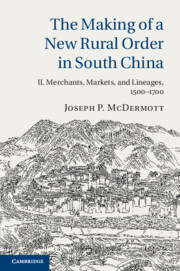Book contents
- The Making of a New Rural Order in South China
- The Making of a New Rural Order in South China
- Copyright page
- Dedication
- Contents
- Tables
- Maps
- Acknowledgments
- Introduction
- 1 Ming Markets and Huizhou Merchants
- 2 Ancestral Halls and Credit
- 3 The Working World of Huizhou Merchants
- 4 Huizhou Merchants and Their Financial Institutions
- 5 Huizhou Merchants and Commercial Partnerships
- 6 Huizhou House Firms
- 7 Conclusion
- Bibliography
- Index
5 - Huizhou Merchants and Commercial Partnerships
Published online by Cambridge University Press: 22 June 2020
- The Making of a New Rural Order in South China
- The Making of a New Rural Order in South China
- Copyright page
- Dedication
- Contents
- Tables
- Maps
- Acknowledgments
- Introduction
- 1 Ming Markets and Huizhou Merchants
- 2 Ancestral Halls and Credit
- 3 The Working World of Huizhou Merchants
- 4 Huizhou Merchants and Their Financial Institutions
- 5 Huizhou Merchants and Commercial Partnerships
- 6 Huizhou House Firms
- 7 Conclusion
- Bibliography
- Index
Summary
Since the profits from pawnbrokers’ loans fell into relatively few hands, many Huizhou merchants came to rely on commercial partnerships, the formal and informal, to expand their pool of investment capital and the operation of their businesses. Chapter 5 investigates in detail the development of three distinct varieties of these partnerships for both Ming and Qing merchants in general and for Huizhou merchants in particular. Attention is paid to the distinctive principles of each of these types of commercial partnership, which seem to have grown out of specific regional conditions in China and the commercial needs of its itinerant merchants both before and during the Ming. In addition, this chapter explains the Huizhou merchants’ solutions to such common problems of business governance as bankruptcy and a merchant’s access to his committed investments during the contracted period of investment
Keywords
- Type
- Chapter
- Information
- The Making of a New Rural Order in South China , pp. 252 - 307Publisher: Cambridge University PressPrint publication year: 2020

